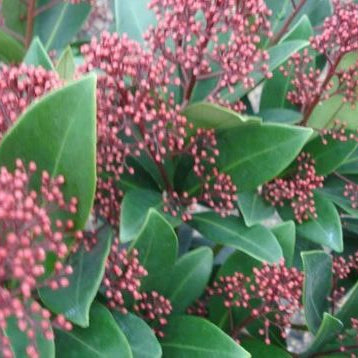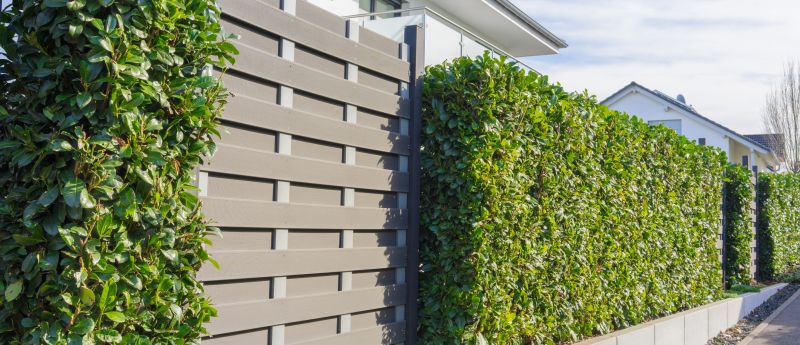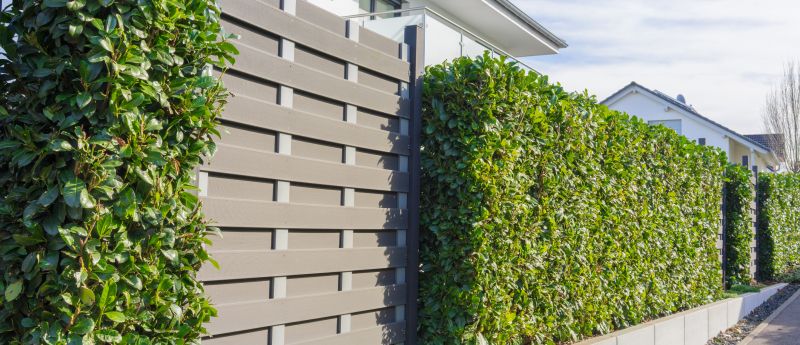
Free Delivery £400+*
Hedging, Tree, Shrubs & more
Free Delivery £400+*

Planting a laurel hedge elevates your garden's aesthetics, offering both beauty and privacy.

Our Quick Guide:
Remember to regularly inspect your hedge for pests and diseases, and take prompt action if you notice any issues. Look HERE for a more detailed guide.

The best time to plant a laurel hedge largely depends on the weather and climate in your region, as well as the type of laurel you're planting. However, in general, the ideal times for planting a laurel hedge are during the late autumn or early spring.
Here's why:
✓ Moderate Temperatures: During the autumn months, temperatures are usually milder, which is favourable for root establishment without the stress of extreme heat.
✓ Moisture Availability: The soil retains moisture better in the fall, reducing the need for excessive watering.
✓ Less Stress on Plants: Planting in the fall allows laurels to establish their root systems over the winter, so they're better prepared to handle the heat and drought of the following summer.
✓ Early Growth: Come spring, laurels planted in the fall will have already developed strong roots and can put their energy into above-ground growth.
✓ Warmer Temperatures: Spring offers warmer weather, which encourages new growth as soon as the laurels are planted.
✓ Extended Growing Season: Planting in the spring gives the laurels a long growing season ahead.
✓ Blossoming Potential: Certain laurel varieties, like Cherry Laurel, produce beautiful spring blooms when planted in early spring.
While late autumn and early spring are generally recommended, it's essential to consider your specific location and climate. In areas with extreme heat or cold, it might be best to plant in the milder months for a more successful establishment.
Regardless of the season, always ensure your laurel hedge receives adequate water during the initial months after planting to help the roots settle in. Adding mulch around the base of the plants can also help retain soil moisture and suppress weeds, aiding in a successful hedge establishment.

Choose the Correct Spot: Select a location that receives partial to full sunlight. Ensure the soil is well-draining and fertile.
Prepare the Soil: Dig a trench at least twice as wide as the laurel root ball and deep enough to accommodate it comfortably. Improve the soil by adding organic compost for nutrients.
Select Your Laurel Plants: Purchase healthy laurel plants from a reputable nursery or garden centre. Choose the right variety for your needs, as laurels come in different sizes and colours.
Plant Spacing: Space your laurel plants about 2 to 3 feet apart, depending on the variety. This will create a dense hedge when they mature.
Planting: Gently remove the laurel plant from its container and place it in the trench. Position it so that the top of the root ball is level with the ground surface.
Backfill: Fill the trench with soil, pressing it down firmly to remove air pockets. Water thoroughly to settle the soil.
Mulch: Apply a layer of mulch around the newly planted laurels to retain moisture, suppress weeds, and regulate soil temperature.
Watering: Keep the soil consistently moist, especially during the first year after planting. Water deeply when necessary, but avoid waterlogging.
Pruning: Prune your laurel hedge as needed to maintain the desired shape and size. The best time for major pruning is in late winter or early spring.
Fertilise: Feed your laurel hedge with a balanced fertiliser in the spring to encourage healthy growth.
Maintenance: Regularly inspect your hedge for pests and diseases, and take prompt action if you notice any issues.

Proper Planting: Ensure you've planted your laurel hedge in well-draining soil with good organic content. Adequate soil preparation is essential for healthy growth.
Pruning: Regularly trim the top and sides of your laurel hedge to stimulate new growth. Pruning should be done during the growing season.
Fertilise: Apply a balanced, slow-release fertiliser in the spring to provide essential nutrients that promote vigorous growth.
Watering: Keep your laurel hedge adequately hydrated, especially during dry spells. Consistent moisture is crucial for optimal growth.
Sunlight: Ensure your laurel hedge receives adequate sunlight, typically at least 4-6 hours of direct sunlight daily.
Mulch: Apply a layer of organic mulch around the base of your laurel hedge to retain soil moisture, regulate temperature, and provide nutrients as it decomposes.
Spacing: Plant your laurel hedge at the recommended spacing to allow for proper air circulation and light penetration, which aids in faster growth.

When it comes to fertilising your laurel hedge, choosing the right fertilisers can make a significant difference in its growth and health. Here are some of the best fertilisers for laurel hedging:
Slow-Release Granular Fertilisers: Slow-release granular fertilisers are a popular choice for laurel hedges. They provide a steady supply of nutrients over an extended period, ensuring consistent growth and greenery.
Balanced NPK Fertilisers: Look for balanced fertilisers with an NPK (nitrogen, phosphorus, and potassium) ratio suited for hedge plants. A balanced formula, such as 10-10-10, promotes overall growth and foliage health.
Organic Compost: Organic compost is an excellent natural fertiliser for laurel hedging. It enriches the soil with organic matter, improves its structure, and enhances nutrient absorption. Apply compost as a mulch around the base of the hedge.
Liquid Fertilisers: Liquid fertilisers, particularly those high in nitrogen, can be applied during the growing season to provide a quick nutrient boost. They are absorbed rapidly by the roots and can help address nutrient deficiencies.
Specialised Hedge Fertilisers: Some companies offer specialised hedge fertilisers designed to meet the specific needs of hedge plants like laurel. These products often contain a blend of micronutrients tailored for hedges.
Slow-Release Fertiliser Spikes: Fertiliser spikes are convenient for deep-rooted laurel hedges. They slowly release nutrients directly into the root zone, ensuring efficient nutrient uptake.
Seaweed Extract: Seaweed extract or kelp-based fertilisers are rich in micronutrients and growth-promoting hormones. They can enhance the overall health and vitality of laurel hedges.
Remember to follow the manufacturer's instructions for application rates and timing, and always water the hedge thoroughly after fertilising to help nutrients penetrate the root zone effectively. Proper fertilisation will contribute to lush, vibrant laurel hedging.
Why Grasslands Nursery:
With over 35 years' of experience, we have the knowledge and expertise to help you find the perfect laurel hedging for your space. Contact us today for further information and advice!
When planting laurel hedging, it's recommended to space the individual laurel plants approximately 2 to 3 feet (60-90 cm) apart. This spacing allows the laurels to grow and fill in the hedge while providing adequate room for each plant to develop fully. Proper spacing ensures a healthy and dense laurel hedge over time.
The best time of year to plant a laurel hedge is during the late autumn or early winter months, typically from November to early March when the laurel plants are dormant.
Planting during this period allows the laurels to establish their root systems before the onset of spring growth. However, laurel hedges can be planted year-round if you can provide adequate care and protection during extreme weather conditions.
A laurel hedge typically takes about 2 to 3 years to establish itself fully. During this period, the laurel plants will develop a strong root system and grow to their desired height and density. Regular maintenance, such as pruning and watering, can help accelerate the establishment process and ensure a healthy, vibrant laurel hedge.
A laurel hedge is an excellent idea for homeowners looking to enhance their property's privacy, aesthetics, and greenery. With its fast growth, dense foliage, and low maintenance requirements, a laurel hedge offers a cost-effective and visually appealing solution for creating a natural boundary or decorative element in your garden or landscape.
Newly planted laurels should be watered regularly during their first growing season to establish healthy root systems. Typically, providing about 1-2 inches of water per week, either through rainfall or manual watering, is sufficient to keep the soil consistently moist but not waterlogged.
Cherry laurels are a very popular hedge as they are evergreen and can grow upto the 3 feet a year. Laurels have large, glossy green leaves, very sm...
View full detailsPrunus Lusitanica - Portuguese Laurel are fantastic laurels that are a great alternative to the classic cherry Laurel. They are more formal in app...
View full detailsBrenelia is a very hardy form of portuguese laurel that also grows a little faster, in a very tidy manner with much redder stems. More graceful in...
View full detailsClassic laurel hedging. It's the country's favourite hedging shrub. Lovely luxurious evergreen dark green leaves. Grows easily in all soils except ...
View full detailsThe posh form of laurel hedging. They cost a little more than common laurel but they are more graceful in appearance with purple shoots and finer l...
View full detailsPrunus lusitanica Angustifolia - Portuguese Laurel are fantastic laurels that are a great alternative to the classic cherry Laurel. They are more f...
View full detailsClassic laurel hedging. It's the country's favourite hedging shrub. Lovely luxurious evergreen bright green leaves. Grows easily in all soils excep...
View full detailsPrunus lusitanica Angustifolia - Portuguese Laurel are fantastic laurels that are a great alternative to the classic cherry Laurel. They are more f...
View full detailsPrunus Lusitanica - Portuguese Laurel are fantastic laurels that are a great alternative to the classic cherry Laurel. They are more formal in appe...
View full details